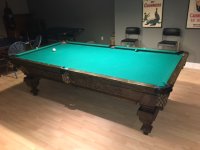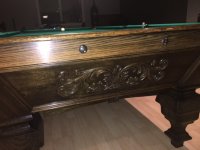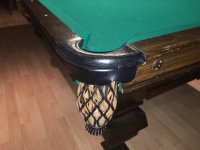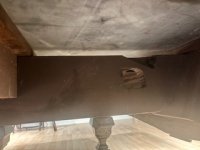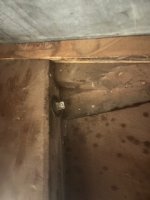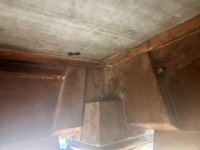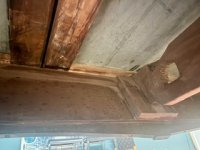My father bought this pool table from Blatt Billiards (NYC) maybe 40+ years ago ... there's no markings or names on it ... just curious if anyone knows how I might find its origin,, age, etc.? I checked with Blatt but they don't have their records from that long ago.
You are using an out of date browser. It may not display this or other websites correctly.
You should upgrade or use an alternative browser.
You should upgrade or use an alternative browser.
How to identify this old pool table?
- Thread starter decayn
- Start date
... bought this pool table from Blatt Billiards (NYC) maybe 40+ years ago .... I checked with Blatt but they don't have their records from that long ago.
"That long ago, lol."
Except maybe the rails, i would not have guess the table was that old.
No doubt someone with more knowlege will appear soon.
What size is it?
Can you post s shot of the underside showing the structure and the slates?
snookered_again
Well-known member
I'm wondering if the style of the rails , being squared off like a pool table and not rounded like a snooker table, indicates that it's been "updated" to play 8 ball etc.
question: when did this style of ( square-ish ) rail first come into popularity?
the legs and repwood "carvings" might be a way to find others like it, in old pictures etc.
question: when did this style of ( square-ish ) rail first come into popularity?
the legs and repwood "carvings" might be a way to find others like it, in old pictures etc.
Here are pictures from the bottom … and it’s a 9ft table."That long ago, lol."
Except maybe the rails, i would not have guess the table was that old.
No doubt someone with more knowlege will appear soon.
What size is it?
Can you post s shot of the underside showing the structure and the slates?
Attachments
Yeah it looks completely hand carved from the bottom. I’ll reach out to one of the names suggested to see if they have any other ideas.That's older than the applied carvings, non-veneered/non grain matched legs, & overall style of finish make it appear on the surface.
Maybe it was "restored" at some point, but i don't know enough to guess the maker.
snookered_again
Well-known member
repwood is very common in a lot of radios I collect, mainly from the early 30's If you take sawdust and hide glue, pack it into an intricate mold and let dry it looks like a hand carving. It was usually applied and then given a coat of a dark brown lacquer toner. Its generally pretty stable.
If you were to actually do a carving like that it would require a lot of the surface to be removed in order to make it proud of the surface.
If it were the opposite, where a design is carved in below the surface it could be a wood carving. I do not beliecve it is carved.
If you were to strip it you may notice it has no grain pattern , but it does resemble wood because it is, its just made from sawdust not one piece.
of course the intricate carving may still be the work of a carver, the original material could be clay or some other substance. it is still "art" just not a one off. The same carving could then be replicated by a molding process.
similar can be done in plaster, but repwood is harder and tougher.
Repwood was a common and cheap way to make people think they were buying carving. The foolery is still working.
with radios of the era. stain was not often used, it was usually a very dark lacquer toner. You can easily remove the finish with stripper or lacquer thinner or acetone.
shellac is made by dissolving shellac flakes in alcohol, testing it in an inconspicuous spot with alcohol can prove if alcohol will dissolve it.
Lacquer can also be dissolved but its a bit more resistant to alcohol than shellac is. this is one way to differentiate between the two.
from my experience , many older antiques are shellac and most of the 1930's and 40's "production furniture " is laquer.
laquer was used in production shops as it is fast to apply , dry and send out.
shellac can be padded on applied in other ways, but if it is a high end piece like a piano it may have french polish. french polishing was a trade in itself, but basically they are padding on a mixture of alcohol and shellac , the technique is learned. spraying shellac is easier and fast.
as furniture makers went from being one off to mass production then laquer became the finish of choice. of course both may be used and both are old finishes.
most any 1930's radio or 1940's "waterfall" dresser is laquer.
one way to date antiques is from the style of the legs. the style of leggs changed over time and is often a good way to differentiate age.
I'm guessing it is 1920's 1930's era based on the repwood carving style and the legs. this is of course not accurate just a guess
I have a brunswick balke collender from the early 1900's to maybe 1915 or so . Im not seeing resemblance in the frame design which seemed to have a lot of commonalities with other BBC's of the same era.
have a really good look underneath, you may find some sort of ink stamp, look close with a good light.
on my BBC every part of it is stamped wiht a corresponding number, including the slate, also under the slate , on the topside of the frame where you can't see without removal of the late, it is head it is marked "head" - this is an ink stamp.
my table has big square legs a lot of the earlier tables have more ornately carved legs.
some of the related styles might relate to art neveau, a french inspired style, art deco ws more squares and rounded shapes, more invnventive less traditional. You may fin books that go into the intracacies of leg style and that is often a way to get an indication of age. Id say art neveau may be indicative of an earlier date while art deco or might be 30's "waterfall" was 1940's these are complete generaliations not proof. It wasnt; like a switch was thrown and every style changed instantly. you can look into the "arts and crafts movement" and "stickley furniture" and see if you see resemblances to these eras it maybe a clue. I don't think it has victorian era influences or victorian style.
I bet if you lok at enough images from magazine ads of the era youll find tables wiht the same legs, If you find that you are on to something. the "internet archives" might be helpful. old pool table mechanics might recognise it.
If you were to actually do a carving like that it would require a lot of the surface to be removed in order to make it proud of the surface.
If it were the opposite, where a design is carved in below the surface it could be a wood carving. I do not beliecve it is carved.
If you were to strip it you may notice it has no grain pattern , but it does resemble wood because it is, its just made from sawdust not one piece.
of course the intricate carving may still be the work of a carver, the original material could be clay or some other substance. it is still "art" just not a one off. The same carving could then be replicated by a molding process.
similar can be done in plaster, but repwood is harder and tougher.
Repwood was a common and cheap way to make people think they were buying carving. The foolery is still working.
with radios of the era. stain was not often used, it was usually a very dark lacquer toner. You can easily remove the finish with stripper or lacquer thinner or acetone.
shellac is made by dissolving shellac flakes in alcohol, testing it in an inconspicuous spot with alcohol can prove if alcohol will dissolve it.
Lacquer can also be dissolved but its a bit more resistant to alcohol than shellac is. this is one way to differentiate between the two.
from my experience , many older antiques are shellac and most of the 1930's and 40's "production furniture " is laquer.
laquer was used in production shops as it is fast to apply , dry and send out.
shellac can be padded on applied in other ways, but if it is a high end piece like a piano it may have french polish. french polishing was a trade in itself, but basically they are padding on a mixture of alcohol and shellac , the technique is learned. spraying shellac is easier and fast.
as furniture makers went from being one off to mass production then laquer became the finish of choice. of course both may be used and both are old finishes.
most any 1930's radio or 1940's "waterfall" dresser is laquer.
one way to date antiques is from the style of the legs. the style of leggs changed over time and is often a good way to differentiate age.
I'm guessing it is 1920's 1930's era based on the repwood carving style and the legs. this is of course not accurate just a guess
I have a brunswick balke collender from the early 1900's to maybe 1915 or so . Im not seeing resemblance in the frame design which seemed to have a lot of commonalities with other BBC's of the same era.
have a really good look underneath, you may find some sort of ink stamp, look close with a good light.
on my BBC every part of it is stamped wiht a corresponding number, including the slate, also under the slate , on the topside of the frame where you can't see without removal of the late, it is head it is marked "head" - this is an ink stamp.
my table has big square legs a lot of the earlier tables have more ornately carved legs.
some of the related styles might relate to art neveau, a french inspired style, art deco ws more squares and rounded shapes, more invnventive less traditional. You may fin books that go into the intracacies of leg style and that is often a way to get an indication of age. Id say art neveau may be indicative of an earlier date while art deco or might be 30's "waterfall" was 1940's these are complete generaliations not proof. It wasnt; like a switch was thrown and every style changed instantly. you can look into the "arts and crafts movement" and "stickley furniture" and see if you see resemblances to these eras it maybe a clue. I don't think it has victorian era influences or victorian style.
I bet if you lok at enough images from magazine ads of the era youll find tables wiht the same legs, If you find that you are on to something. the "internet archives" might be helpful. old pool table mechanics might recognise it.
snookered_again
Well-known member
can you see a resemblance between the leg style of your table an this one?


ANTIQUE BRUNSWICK POOL TABLE - toys & games - by owner - craigslist
Brunswick Bailke Collender POOL TABLE, 4' X 8' Solid Oak circa 1860 approximately 163 yrs old, replaced wine coloured felt, includes original ball rack and cue rack. Cushions & Brass/Leather...
vancouver.craigslist.org
See, that right there is why it does not present as old to me if you only look at the exterior.
I have trouble imagining anyone going to the trouble - but what it looks like is that someone stripped all the veneer off an old table, glued up and repaired cracks in the core, found some repro carvings to apply; then stained, sealed, toned, and finished it. Tables like that, just were not made like that in the "old days". You can see in the link that real old time legs were fully veneered, and so was the case. The legs on the OP table look like cores that were never veneered. (they are awfully clean and crisp if someone stripped them, but still possible). That style of construction started mostly with lower end tables and import tables after the 1960's.
OTOH just about the time i think i know what i'm talking about, some odd ball from ancient history shows up and shoots all my theories to heck.
Any chance the inside of the frame is veneered? The sloped exterior pieces, not the cross pieces & supports.
Snookered -
Back in the late 80's you could still go to a carving shop, and if you made the models or if they had something stock hanging on the wall, you could get stuff like that made in solid wood. I made the models and got sets for curved church pews i was making accurate reproductions of. in QS w. oak. I supplied the materials and the models for the 12 spindle carving machine. But they were much smaller about 4" x 4", and 4" x 6". They weren't expensive. They then did the hand gashing, and i did the detail carving to remove machine marks. Some shops even had catalog patterns of various sizes. The shop i used in southern PA burned to the ground in the 1990's or early 2000's. Too bad, it was reported to be profitable. Part of what fueled the fire was thousands of feet of prime, thick, mahogany.
I have trouble imagining anyone going to the trouble - but what it looks like is that someone stripped all the veneer off an old table, glued up and repaired cracks in the core, found some repro carvings to apply; then stained, sealed, toned, and finished it. Tables like that, just were not made like that in the "old days". You can see in the link that real old time legs were fully veneered, and so was the case. The legs on the OP table look like cores that were never veneered. (they are awfully clean and crisp if someone stripped them, but still possible). That style of construction started mostly with lower end tables and import tables after the 1960's.
OTOH just about the time i think i know what i'm talking about, some odd ball from ancient history shows up and shoots all my theories to heck.
Any chance the inside of the frame is veneered? The sloped exterior pieces, not the cross pieces & supports.
Snookered -
Back in the late 80's you could still go to a carving shop, and if you made the models or if they had something stock hanging on the wall, you could get stuff like that made in solid wood. I made the models and got sets for curved church pews i was making accurate reproductions of. in QS w. oak. I supplied the materials and the models for the 12 spindle carving machine. But they were much smaller about 4" x 4", and 4" x 6". They weren't expensive. They then did the hand gashing, and i did the detail carving to remove machine marks. Some shops even had catalog patterns of various sizes. The shop i used in southern PA burned to the ground in the 1990's or early 2000's. Too bad, it was reported to be profitable. Part of what fueled the fire was thousands of feet of prime, thick, mahogany.
snookered_again
Well-known member
yes often both sides are veneered to avoid warping by presenting the frame with different conditions on either side.
on a table that old the veneer is held by hide glue. Ok so long as it isn't put in a damp or humid environment. if it lived through a flood or similar it may have lost it's veneer.
the one I have was sprayed with a coat of some sort of primer that has the appearance of particleboard and then it was sprayed with atoned shellac, to darken it.
I striped a small area and found some detachment and stopped, yes I could try to save the veneer or replace it but it's a long job. the rails were rosewood and finished OK , and rails and cloth were OK so I just put it into operation. It doesn't look so bad for now. I know to do it right I'd be replacing some veneer of not all the exterior veneer, what Id do is strip it and see what I have to deal with and reattaching is possible but there is a point where it might be easier to re-veneer it.
the legs had small nails I guess in a quick attempt to reattach the veneer, also sprayed. I figure that in a few years I may be retired and maybe Ill make the time to refinish the whole frame properly, for now it's not affecting it's use so I'm choosing not to open that can of worms.
transporting the frame into my shop alone looked hard , it does not disassemble, unless I were to pull every part apart and it's doweled together. best it remains intact. I bet it's 500 lbs or so without it's internal structure. I had to winch it up my front steps and it barely fit through the door, I had to pull some trim off near my door and it just barely fit. I actually moved it all alone in stages. a come along, rollers, etc. moving the slate was the easy part.
antiques are vary patient things, Its possible to continue and do a full restoration, I do know how, I also know it's lots of work. It's not getting any worse now. hopefully it'll still be around in another 100 years.
yes sure it's possible the other one in the original post lost its veneer and was refinished without veneer.
the one I have , It's a real joy to play in being so solidly constructed, very silent. any wood movement due to shrinkage has settled, its also very dimensionally stable. They just dont make 'em like this anymore.
yes with todays's equipment it is possible to 3D scan wood things or write a program, wiht that and something like a 5 axis Maka router it is possible ot crank out carvings all day long. I've looked after the mainenance of such machines. the things they can do are incredible. I have an ornate armchair that is heavily "carved" and appears from the 70's era. might be 80's ? I think it was an early example of such technology. I don't think any carver ever touched it. it's solid oak. there is tecnology now that can make such intricate carvings with no carver or carving skills, and also without the high labor costs.
on a table that old the veneer is held by hide glue. Ok so long as it isn't put in a damp or humid environment. if it lived through a flood or similar it may have lost it's veneer.
the one I have was sprayed with a coat of some sort of primer that has the appearance of particleboard and then it was sprayed with atoned shellac, to darken it.
I striped a small area and found some detachment and stopped, yes I could try to save the veneer or replace it but it's a long job. the rails were rosewood and finished OK , and rails and cloth were OK so I just put it into operation. It doesn't look so bad for now. I know to do it right I'd be replacing some veneer of not all the exterior veneer, what Id do is strip it and see what I have to deal with and reattaching is possible but there is a point where it might be easier to re-veneer it.
the legs had small nails I guess in a quick attempt to reattach the veneer, also sprayed. I figure that in a few years I may be retired and maybe Ill make the time to refinish the whole frame properly, for now it's not affecting it's use so I'm choosing not to open that can of worms.
transporting the frame into my shop alone looked hard , it does not disassemble, unless I were to pull every part apart and it's doweled together. best it remains intact. I bet it's 500 lbs or so without it's internal structure. I had to winch it up my front steps and it barely fit through the door, I had to pull some trim off near my door and it just barely fit. I actually moved it all alone in stages. a come along, rollers, etc. moving the slate was the easy part.
antiques are vary patient things, Its possible to continue and do a full restoration, I do know how, I also know it's lots of work. It's not getting any worse now. hopefully it'll still be around in another 100 years.
yes sure it's possible the other one in the original post lost its veneer and was refinished without veneer.
the one I have , It's a real joy to play in being so solidly constructed, very silent. any wood movement due to shrinkage has settled, its also very dimensionally stable. They just dont make 'em like this anymore.
yes with todays's equipment it is possible to 3D scan wood things or write a program, wiht that and something like a 5 axis Maka router it is possible ot crank out carvings all day long. I've looked after the mainenance of such machines. the things they can do are incredible. I have an ornate armchair that is heavily "carved" and appears from the 70's era. might be 80's ? I think it was an early example of such technology. I don't think any carver ever touched it. it's solid oak. there is tecnology now that can make such intricate carvings with no carver or carving skills, and also without the high labor costs.
Last edited:
snookered_again
Well-known member
My BBC has 4 slate bolts through each rail section. the bolts appear the same with two pin holes, a rounded low profile head and that inner hole is threaded.
the two pin holes are to fit a pin wrench.
if you compare to other BBC's , some have an ornate cover that threaded into the center of the slate bolt, perhaps brass.
others, like mine, have rail covers that completely hide the bolt heads. mine are held in place by the same bolts that go into the pocket irons.
I had 3 missing and they are an odd thread so I installed 3 Helicoils to change it to 5/16 coarse thread. the old ones were 5/16 but the TPI was not a common pitch.
I'm missing one slate bolt. My gut feeling is that this is a BBC but I could be wrong, it happened once before ;-)
a question that you could ask is are the same slate bolts used by other manufacturers? They could have been made in shop by BBC or perhaps supplied by some small manufacturer of the day.
I dont know how many other tables would have slate bolts into the edges of the slate rather than bolts up in through the bottom of the rails.
the two pin holes are to fit a pin wrench.
if you compare to other BBC's , some have an ornate cover that threaded into the center of the slate bolt, perhaps brass.
others, like mine, have rail covers that completely hide the bolt heads. mine are held in place by the same bolts that go into the pocket irons.
I had 3 missing and they are an odd thread so I installed 3 Helicoils to change it to 5/16 coarse thread. the old ones were 5/16 but the TPI was not a common pitch.
I'm missing one slate bolt. My gut feeling is that this is a BBC but I could be wrong, it happened once before ;-)
a question that you could ask is are the same slate bolts used by other manufacturers? They could have been made in shop by BBC or perhaps supplied by some small manufacturer of the day.
I dont know how many other tables would have slate bolts into the edges of the slate rather than bolts up in through the bottom of the rails.
yes with todays's equipment it is possible to 3D scan wood things or write a program, with that and something like a 5 axis Maka router it is possible ot crank out carvings all day long. I've looked after the maintenance of such machines. the things they can do are incredible. I have an ornate armchair that is heavily "carved" and appears from the 70's era. might be 80's ? I think it was an early example of such technology.
You are confused and don't know some of your own history. Manually operated multi-spindle carvers have been in use since the 1870's.
The operator stands at the center station and manually traces a model in place there. On many machines the model can rotate, and is linked to the work stations as well, to carve all sides of some work.
Until a few years ago, a multi-spindle carver was still faster than a cnc machine, because it could do up to 32 copies at once, in some cases. However, i gather that cnc is being applied to some old multi-spindle machines. Also, on-shore, we probably don't make enough product to use the out-put of a gang of 24 or 32 spindle machines, as in the old daze. It does seem that very recently, cnc carvers have included up to 8 spindles. So cnc seems to be catching up, and even a slower cnc might be preferable given that it takes a lot less skill to set up, tool up, and run than a real live old-fashioned multi.
A separate machine the "spindle carver" singular, is used differently but in conjunction with the multi-spindle copy machine. The operator uses it with various cutters, freehand, to gash and detail carvings with the accent details applied to many old carvings. This one is in French but it is the only one i can find that is not either totally bogus, or does not use the small cutters like this once does for details. Just turn off the sound and watch the details.
PS, if your table is BBC, it comes apart with the removal of a few bolts.
Unless for some reason it was heavily moditified and glued together.
Other than possibly arguing against including convertible rail tables, BBC tables were all T- rail (bolts in the edges) until the era of the Anniversary and Centennials. Most other makes of table were as well, and a few still are or were in modern videos within the past decade or so.
Last edited:
Snookered and Ssonerai - thanks so much for your insights and suggestions. I think it might be a BBC Challenge with some additional designwork added on. The 2-pin bolts and the bolts underneath match what I found in some old BBC pitures. Plus this listing on Etsy seems to be the exact table minus the designwork which could have been easily added. I can't find any stampings or markings though to indicate it's an actual BBC.
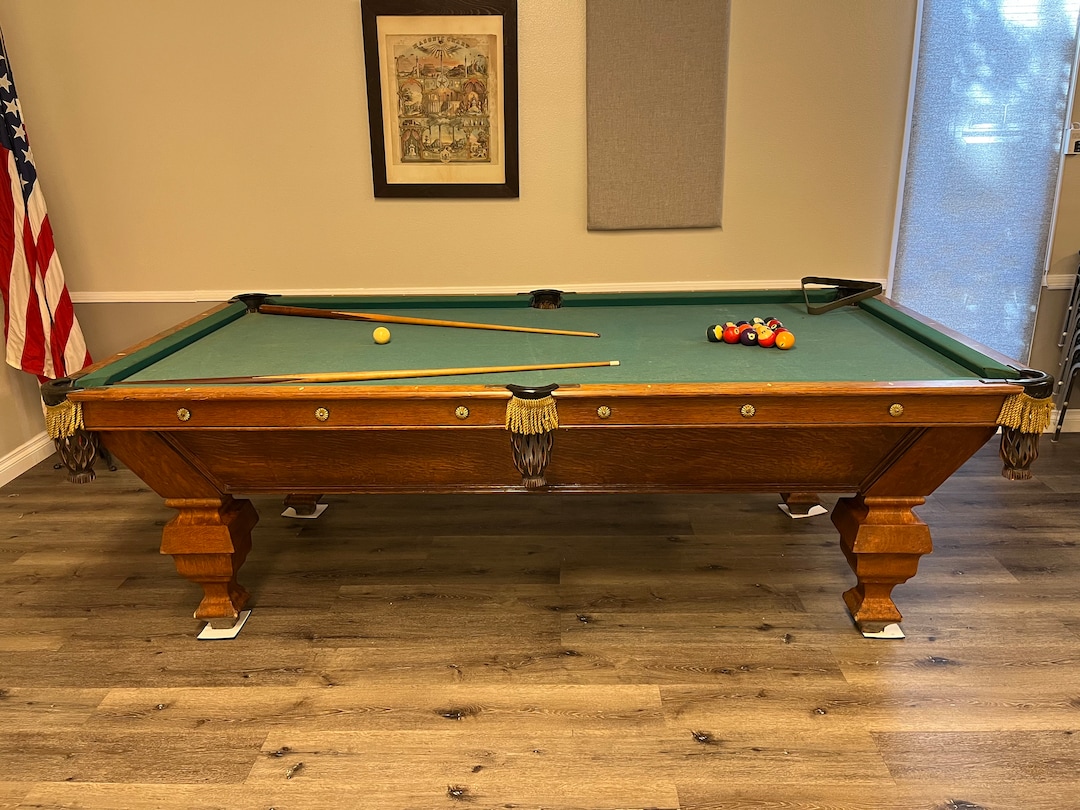
 www.etsy.com
www.etsy.com

Antique Brunswick-balke-collender Billiards Pool Table With Monarch Cushion - Etsy
This Pool & Billiards item by VintiqueHouse has 27 favorites from Etsy shoppers. Ships from Fallbrook, CA. Listed on Jul 14, 2024
snookered_again
Well-known member
a few things I noted were that your table appears to have similar great big diamond shaped diamonds made of Ivory. The rails are rosewood, at least near the top surface.
In that Etsy add, I noticed that the pockets are cut out on a 45 degree angle. and then there is a wood piece that is knitted in to form the pocket ledge. On mine this cutout in the slate is not done on a 45 degree angle, it is cut on a similar U shape to the pocket profile but there is a similar wood piece which I guess protects the hard edge of the slate from the balls. the edge of the U shape is not square to the top surface, its on a bevel.
when I saw how the pockets on the etsy one were cut, It made me wonder if perhaps this was a carom table that was modified to have pockets or perhaps the slate was replaced. It would be easier to ut the slate on a 45, Rather than trying to cut a U shape out of the slate in order to add pockets that never existed or modify another piece of slate to fit.
on mine, two of those (wooden) pocket edge pieces had been recreated ( the wood was not darkened from age) and they hadn't mirrored the other pockets well, the shelf was deeper, I cut them similar to the two that appeared very old and not messed with by taking patterns off the other end which I believe is original.
the pockets on the etsy one look the same as mine, and the bolts and methodology for attaching the frame members are similar. mine has a super long bolt through the frame from one end to the other. The frame of mine was never intended or designed to be disassembled , it was shipped with the frame in one basic huge part, the rails that intersect below the slate are removable.
on the "etsy " one , it appears the frame is able to come apart at the corners so the frame may be disassembled. On mine the frame is doweled and does not come apart on the corners. The frame is super heavy, mine has more structure, there is a crossmember at all the areas where the slates butt together. as a result , moving the table frame was a big deal because it is super heavy and also one very large piece.
I think BBC may have had options as to wheather or not the frame came apart or not. the one on etsy has bolts near the legs, mine has no such bolts in that area. It does have smilar square head bolts and cutouts that attach the 3 cross members to the edges. It has no such bolts near the legs.
I don't know if yours has been embellished with non original parts or not. there seem to be quite a few variations. I figured mine may have had some repwood ( carved look) ornamentation that had been lost but I'm not sure if that is true.
I have not seen other tables with great big ivory diamnd shaped diamonds, most seem to have a smaller and usually round "diamond" Mine has 3 per rail, many tables have less of them.
I found it interesting to read that Brunswick had made some special anniversary editions , copying their original plan but with those they claimed to have diamonds made of "chinese waterbuffalo bone" I thought maybe that was an elloquent way around the topic of them perhaps not being able to use real Ivory due to it being a banned substance.
I'm loving mine, it is also a "ten foot" I think it's 100 x 50 inches playing surface. I like to play snooker on a larger 12' 1924 table with smaller pockets. that one is made in Canada but i'd consider it more akin to an english style snooker table.
the pockes on mine , are not nearly as challenging and I believe it was actually designed to use 2 1/4" balls. The rails are higher. I found my table will run either the 2 1/16" or the 2 1/4" quite sucessfully whereas the snooker table that I play on has rails so low that it tends to launch the balls on return of any hard shots.
i have both sets but Ive been practicing with the 2 1/16" so that Im not always using different ball sizes. for the smaller balls I'd use a snooker cue with about a 10mm tip with a dime radius and but maybe if you use 2 1/4" you want something more like a 8 ball cue with a 12 or 13mm tip size and a nickle radius.
playing on my home table with big pockets of course makes it a lot easier to make higher point runs, but Im finding that's ok I'd rather that, than than keep changing cues and ball sizes for practicing.
every rail and wood component and the slates are stamped with the same number on mine. I think if you start seeing parts that dont have numbers it may mean something. the slate is ink stampled so it could be lost but the frame parts that are bolted to the slates are also stamped with the same number, into the wood.
I noted that while the top side of the slate is fairly consistent there are some original surface imperfections. the underside of the slate is quite porous in areas..
I think if someone had went ahead and used slate from some other newer table you may find that the slate pieces are more consistent on both sides. I believe it is vermont slate.
Im not ever going to fit a 12' table in my house, but I managed to make this 10' one work out ok. No doubt playing snooker on a table with different dimensions is a different game but it's all practice anyway. I guess if one wanted they could run 8 or 9 ball and then they would have the wrong pocket and rail style and the wrong cloth but even still , its a fair game for those at the table.
I'm not all that savy about the differneces but I think traditional english pool is usually played on the big tables with small pockets whereas"american snooker might be a bit different, one rule being that you have to involve a bank or it's a foul, In english style it is fine to hook your opponent by making a slow shot up against a ball and not involve a bank.
Here in Canada during the days of these tables, we in Canada were pretty closely tied to England politically. I think a lot of the serious snooker players may have then trended towards the british style game. Perhaps in the US it was common to pay the US version. I do not know if my table was made in the US or Canada but I think BBC did have Canadian factories. Id like to learn more about how my table was originally intended to be used and for what game exactly. It may be that games like straight pool were played on these tables and perhaps they predated the emergence of snooker's popularity. I tend to look at the rounded corners and think that' sa snooker table , but perhaps it was just that rounded corners were how all the tables with pockets started originally and the emergence of 8 ball may have made the 8 ball style rails popular but at a later date.
my table , and other BBC's of the era was available either as carom ( no pockets) or "pool" ( with pockets) I do not think there were any tables made this early with the square cut rails typical of 8 ball. I also don't think I've seen any early dated reference to the BBC's as being actually called "snooker tables"
someone that knows the history better may know with better accuracy, at what date the square rails became popular.
I find it a bt interesting and slightly confusing because now people like to refer to pool or snooker, but may not consider snooker "pool" The origional sales literature calls them "pool" or carom.
i think what happened is the populaity of these games and some of the terminology changed over time and now we spot a table with rounded corners and call it a "snooker table" but in fact snooker may not really have been their original intent. I think snooker actually grew in popularity after they were constructed. If they were intended as snooker tables then the original pamphlets would hhave referred to them as snooker tables.
i obviously dont have all the history nailed down , Im no history expert, but if you own one of course you start thinking about where it came from, how they used it, what games were played on it and such. Perhaps there is some merit to wanting to use it as it was originally intended.
In that Etsy add, I noticed that the pockets are cut out on a 45 degree angle. and then there is a wood piece that is knitted in to form the pocket ledge. On mine this cutout in the slate is not done on a 45 degree angle, it is cut on a similar U shape to the pocket profile but there is a similar wood piece which I guess protects the hard edge of the slate from the balls. the edge of the U shape is not square to the top surface, its on a bevel.
when I saw how the pockets on the etsy one were cut, It made me wonder if perhaps this was a carom table that was modified to have pockets or perhaps the slate was replaced. It would be easier to ut the slate on a 45, Rather than trying to cut a U shape out of the slate in order to add pockets that never existed or modify another piece of slate to fit.
on mine, two of those (wooden) pocket edge pieces had been recreated ( the wood was not darkened from age) and they hadn't mirrored the other pockets well, the shelf was deeper, I cut them similar to the two that appeared very old and not messed with by taking patterns off the other end which I believe is original.
the pockets on the etsy one look the same as mine, and the bolts and methodology for attaching the frame members are similar. mine has a super long bolt through the frame from one end to the other. The frame of mine was never intended or designed to be disassembled , it was shipped with the frame in one basic huge part, the rails that intersect below the slate are removable.
on the "etsy " one , it appears the frame is able to come apart at the corners so the frame may be disassembled. On mine the frame is doweled and does not come apart on the corners. The frame is super heavy, mine has more structure, there is a crossmember at all the areas where the slates butt together. as a result , moving the table frame was a big deal because it is super heavy and also one very large piece.
I think BBC may have had options as to wheather or not the frame came apart or not. the one on etsy has bolts near the legs, mine has no such bolts in that area. It does have smilar square head bolts and cutouts that attach the 3 cross members to the edges. It has no such bolts near the legs.
I don't know if yours has been embellished with non original parts or not. there seem to be quite a few variations. I figured mine may have had some repwood ( carved look) ornamentation that had been lost but I'm not sure if that is true.
I have not seen other tables with great big ivory diamnd shaped diamonds, most seem to have a smaller and usually round "diamond" Mine has 3 per rail, many tables have less of them.
I found it interesting to read that Brunswick had made some special anniversary editions , copying their original plan but with those they claimed to have diamonds made of "chinese waterbuffalo bone" I thought maybe that was an elloquent way around the topic of them perhaps not being able to use real Ivory due to it being a banned substance.
I'm loving mine, it is also a "ten foot" I think it's 100 x 50 inches playing surface. I like to play snooker on a larger 12' 1924 table with smaller pockets. that one is made in Canada but i'd consider it more akin to an english style snooker table.
the pockes on mine , are not nearly as challenging and I believe it was actually designed to use 2 1/4" balls. The rails are higher. I found my table will run either the 2 1/16" or the 2 1/4" quite sucessfully whereas the snooker table that I play on has rails so low that it tends to launch the balls on return of any hard shots.
i have both sets but Ive been practicing with the 2 1/16" so that Im not always using different ball sizes. for the smaller balls I'd use a snooker cue with about a 10mm tip with a dime radius and but maybe if you use 2 1/4" you want something more like a 8 ball cue with a 12 or 13mm tip size and a nickle radius.
playing on my home table with big pockets of course makes it a lot easier to make higher point runs, but Im finding that's ok I'd rather that, than than keep changing cues and ball sizes for practicing.
every rail and wood component and the slates are stamped with the same number on mine. I think if you start seeing parts that dont have numbers it may mean something. the slate is ink stampled so it could be lost but the frame parts that are bolted to the slates are also stamped with the same number, into the wood.
I noted that while the top side of the slate is fairly consistent there are some original surface imperfections. the underside of the slate is quite porous in areas..
I think if someone had went ahead and used slate from some other newer table you may find that the slate pieces are more consistent on both sides. I believe it is vermont slate.
Im not ever going to fit a 12' table in my house, but I managed to make this 10' one work out ok. No doubt playing snooker on a table with different dimensions is a different game but it's all practice anyway. I guess if one wanted they could run 8 or 9 ball and then they would have the wrong pocket and rail style and the wrong cloth but even still , its a fair game for those at the table.
I'm not all that savy about the differneces but I think traditional english pool is usually played on the big tables with small pockets whereas"american snooker might be a bit different, one rule being that you have to involve a bank or it's a foul, In english style it is fine to hook your opponent by making a slow shot up against a ball and not involve a bank.
Here in Canada during the days of these tables, we in Canada were pretty closely tied to England politically. I think a lot of the serious snooker players may have then trended towards the british style game. Perhaps in the US it was common to pay the US version. I do not know if my table was made in the US or Canada but I think BBC did have Canadian factories. Id like to learn more about how my table was originally intended to be used and for what game exactly. It may be that games like straight pool were played on these tables and perhaps they predated the emergence of snooker's popularity. I tend to look at the rounded corners and think that' sa snooker table , but perhaps it was just that rounded corners were how all the tables with pockets started originally and the emergence of 8 ball may have made the 8 ball style rails popular but at a later date.
my table , and other BBC's of the era was available either as carom ( no pockets) or "pool" ( with pockets) I do not think there were any tables made this early with the square cut rails typical of 8 ball. I also don't think I've seen any early dated reference to the BBC's as being actually called "snooker tables"
someone that knows the history better may know with better accuracy, at what date the square rails became popular.
I find it a bt interesting and slightly confusing because now people like to refer to pool or snooker, but may not consider snooker "pool" The origional sales literature calls them "pool" or carom.
i think what happened is the populaity of these games and some of the terminology changed over time and now we spot a table with rounded corners and call it a "snooker table" but in fact snooker may not really have been their original intent. I think snooker actually grew in popularity after they were constructed. If they were intended as snooker tables then the original pamphlets would hhave referred to them as snooker tables.
i obviously dont have all the history nailed down , Im no history expert, but if you own one of course you start thinking about where it came from, how they used it, what games were played on it and such. Perhaps there is some merit to wanting to use it as it was originally intended.
